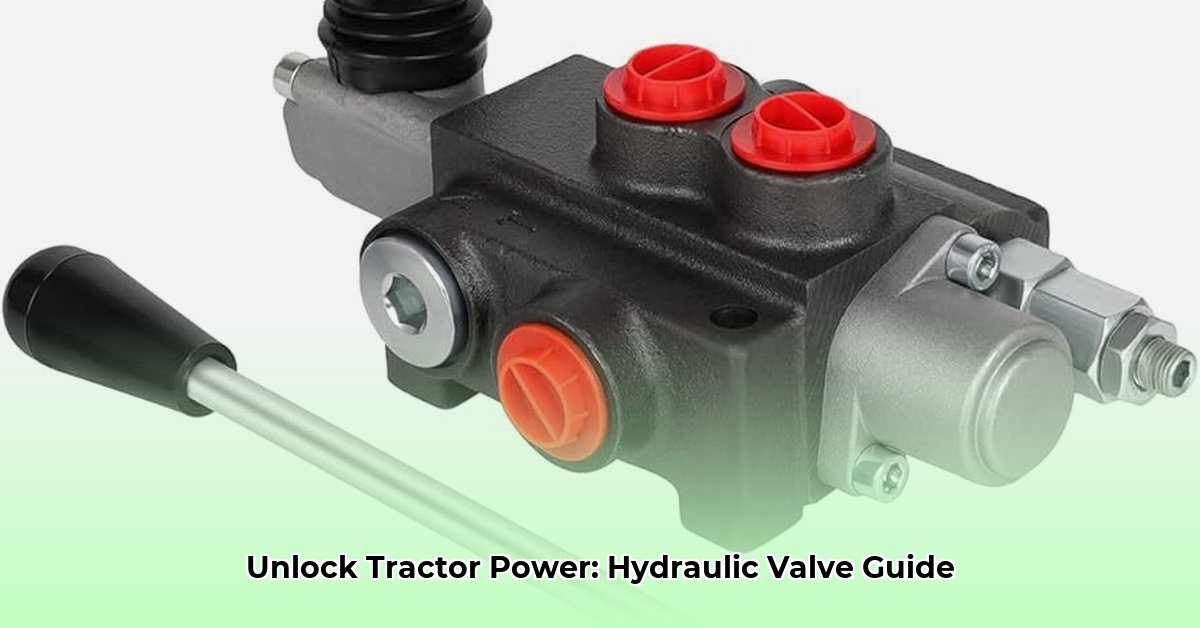
Choosing the correct hydraulic valve for your tractor is crucial for efficient and safe operation. This guide provides a step-by-step process to ensure you select the right valve for your needs, avoiding costly mistakes and maximizing your tractor's potential. We’ll cover key factors, different valve types, and essential safety precautions, empowering you to make an informed decision. For more advanced hydraulic repairs, check out this helpful resource on hydraulic crimpers.
Understanding Your Tractor's Hydraulic System: Open or Closed Center?
Before selecting a valve, determine your tractor's hydraulic system type: open-center or closed-center. This is fundamental for compatibility.
- Open-center systems: The hydraulic pump constantly circulates oil. The valve directs this flow to the implements.
- Closed-center systems: The pump only operates when a valve directs the oil. This improves efficiency but requires careful valve selection.
Consult your tractor's manual to identify your system type. Incorrect valve selection can lead to system failure and damage.
Key Factors in Choosing a Tractor Hydraulic Control Valve
Several factors determine the appropriate valve for your tractor:
Flow Rate (GPM): This specifies the volume of hydraulic fluid (gallons per minute) the valve can handle. Higher GPM allows for faster implement operation but demands a more powerful pump. Match the valve's GPM to your implements' needs. Insufficient GPM results in slow or inefficient operation.
Pressure Rating (PSI): This denotes the maximum pressure (pounds per square inch) the valve can withstand without failure. Exceeding this limit can cause valve damage or even system failure. Always ensure the valve's pressure rating exceeds your tractor's maximum system pressure.
Number of Spools: This indicates how many independent hydraulic functions the valve can control simultaneously. A two-spool valve is sufficient for simple operations, while more complex tasks might require more spools.
Spool Type (Single or Double-Acting): Single-acting cylinders require one hydraulic line for extension, while double-acting cylinders need two lines for both extension and retraction. Choose a valve compatible with your cylinder type.
Valve Mounting and Port Sizes: Verify the valve's mounting dimensions and port sizes match your tractor's hydraulic system. Mismatched components lead to leaks and installation difficulties.
Types of Tractor Hydraulic Control Valves
Several valve types cater to different needs:
- Directional Control Valves: These direct hydraulic fluid flow to control implements like loaders, backhoes, and three-point hitches.
- Pressure Control Valves: These maintain safe system pressure, preventing damage from excessive pressure.
- Flow Control Valves: These regulate the speed of hydraulic fluid flow for precise implement control.
A Step-by-Step Guide to Hydraulic Valve Selection
Follow these steps for effective valve selection:
- Assess your needs: List all implements and their hydraulic requirements (flow rate, pressure).
- Check tractor compatibility: Identify your tractor's hydraulic system type (open or closed-center) and port sizes from your tractor's manual.
- Define valve requirements: Determine the needed number of spools and spool type (single or double-acting).
- Select the valve: Choose a valve exceeding your requirements for flow rate, pressure, and compatibility. Prioritize safety and reliability.
- Final compatibility check: Verify all aspects before purchasing, ensuring the valve perfectly matches your tractor's configuration.
Troubleshooting Common Hydraulic Valve Issues
- Leaks: Inspect all connections and seals for leaks. Tighten loose connections or replace worn seals.
- Sluggish Response: Check for obstructions in the oil flow, low fluid levels, or hydraulic pump problems. A clogged filter is a common culprit.
- No Response: Verify power to the system, check for faulty wiring, or a blown fuse.
Safety Precautions When Working with Hydraulic Systems
Hydraulic systems operate under high pressure. Always:
- Wear appropriate safety glasses and heavy-duty gloves.
- Ensure proper grounding before working on the system.
- Depressurize the system before any maintenance.
- Consult your tractor's manual for specific safety guidelines.
Remember, selecting the correct hydraulic valve is vital for your tractor's safe and efficient operation. Take your time, conduct thorough research, and consult an expert if needed. This investment ensures your equipment's long-term performance and your safety.